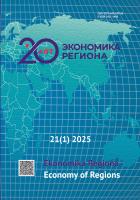Дифференциация регионов России в процессе реиндустриализации
Differentiation of Russia’s Regions in the Process of Reindustrialization
Author(s): Vyacheslav Volchik, Elena MASLYUKOVA, Anastasia A. Barunova, Olesia V. DemakhinaSubject(s): Economy, Geography, Regional studies, Economic history, Socio-Economic Research
Published by: Институт экономики Уральского отделения Российской академии наук
Keywords: reindustrialization; differentiation of regions; scientific and technological development; industrial development; innovative activity; institutional environment;
Summary/Abstract: Russia’s regions are unevenly developed, which results in varying rates of reindustrialization across the country. This article investigates the regional differentiation in the process of reindustrialization, exploring its key factors and examining the unique economic and technological characteristics of different Russian regions. Reindustrialization is a crucial step in modernizing the economy; however, it faces challenges such as workforce qualification, infrastructure gaps, and institutional barriers, all of which contribute to significant regional disparities. The primary goal of this study is to identify the main causes and factors driving regional differences in reindustrialization and to highlight the key directions for this process. To analyse these dynamics, correlation and cluster analyses were employed to examine the relationships between production, scientific, and technological indicators. The correlation analysis revealed links between innovation expenditure, internal research and development costs, and the level of innovation activity in organizations. These findings demonstrate that innovation-supporting policies effectively increase funding for internal research and foster conditions conducive to innovative production, influenced by formal institutional frameworks. Clustering Russian regions according to their scientific, technological, and production potential revealed three distinct groups with varying levels and directions of reindustrialization. The first cluster (19 regions) exhibits the lowest levels of production and scientific-technological development; the second cluster (21 regions) shows relatively stronger scientific-technological factors, despite a weaker position in terms of production; and the third cluster (35 regions) demonstrates an average level of both production and technological development. In light of these findings, the study proposes that the regional differences in reindustrialization rates and directions call for tailored economic policies to effectively address these disparities and support more balanced development across Russia.
Journal: Экономика региона
- Issue Year: 21/2025
- Issue No: 1
- Page Range: 1-16
- Page Count: 16
- Language: Russian

